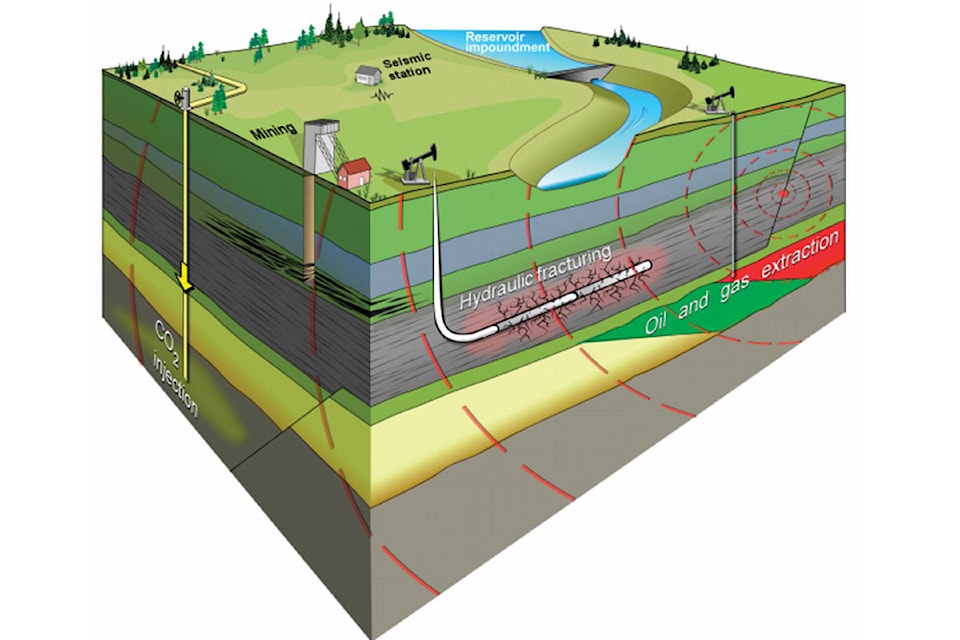Fracking has been confirmed as the cause of an earthquake that rattled homes from Sylvan Lake to Red Deer last March, say government scientists.
“The investigation found that the earthquake was induced by hydraulic fracturing,” said the Alberta Energy Regulator.
The Alberta Geological Survey, a branch of the regulator, undertook the investigation that began shortly after the March 4 earthquake that registered 4.18 on the Richter scale and whose epicentre was about 12 kilometres south of Sylvan Lake.
Last month, a preliminary overview was released of that earthquake and another 3.13 quake near Red Deer in March 2018.
“The shaking from the event was felt by some,” says the Alberta Geological Survey report of the 3.13 earthquake.
By comparison, the 4.18 earthquake was “felt by many,” says the authority. “Complaints of damage from the event were received as well.”
Analysis of seismological data suggested that both earthquakes were “induced,” as were a smaller cluster of seismic events under 2.0 on the Richter scale.
After reviewing historical data, scientists also discovered that oil and gas activity led to another earthquake in the Rocky Mountain House area in 2014.
Calgary-based Vesta Energy was fracking in the Sylvan Lake area when the 4.18 quake was triggered.
Vesta suspended its operations at the site and was required to follow monitoring and reporting protocol and submit a plan to demonstrate how it will “minimize the risk of seismic impacts in the future.”
In May, Vesta was given the green light to resume fracking at sites considered low risk for seismic activity after the Alberta Energy Regulator signed off on a risk assessment plan.
The regulator does not plan to take any additional enforcement against Vesta.
However, the incident led to new seismic monitoring and requirements for all companies fracking in the Red Deer region.
In an emailed reponse to a request for comment, Vesta says that the company “operates in areas with potential for seismicity, and continues to take the necessary precautions to ensure compliance with Alberta Energy Regulator regulations.
“Vesta has sophisticated monitoring equipment placed throughout its operating perimeter to detect seismic activity and works with the AER as needed to report any detections of seismic events in the area.
“The safety of employees, contractors and communities near our operations is paramount for Vesta. We are proud to contribute to the local economy by providing employment opportunities and support to local businesses.”
The Alberta Geological Survey report notes that there has been a “notable increase” in the number of earthquakes attributed to oil and gas development in the Western Sedimentary Basin.
“In particular, hydraulic fracturing has contributed most significantly to the apparent rate change in the past few years,” says the report, noting only a small proportion of wells triggered earthquakes.
The Alberta Geological Survey has used information gleaned from its investigations of the most recent earthquakes to update its models showing the susceptibility of different areas to fracking-caused earthquakes.
Red Deer County Coun. Christine Moore, whose division covers the area where the Sylvan Lake earthquake occurred last year, said some landowners are uneasy about what happened.
“I think there is a concern,” said Moore.
Moore said she was contacted by a rural resident who was having well trouble that they believe was caused by fracking in the Sylvan Lake area. The Alberta Energy Regulator is working with that person now, she said.
“People are worried, and often it is hard to prove (fracking is to blame),” she said.
Moore was glad the incident was investigated.
“I think there are going to be way more restrictions and, obviously, they will be monitored.”
pcowley@reddeeradvocate.com
Like us on Facebook and follow us on Twitter
